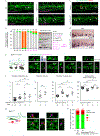VCAM-1+ macrophages guide the homing of HSPCs to a vascular niche
- PMID: 30455424
- PMCID: PMC6492262
- DOI: 10.1038/s41586-018-0709-7
VCAM-1+ macrophages guide the homing of HSPCs to a vascular niche
Abstract
Haematopoietic stem and progenitor cells (HSPCs) give rise to all blood lineages that support the entire lifespan of vertebrates1. After HSPCs emerge from endothelial cells within the developing dorsal aorta, homing allows the nascent cells to anchor in their niches for further expansion and differentiation2-5. Unique niche microenvironments, composed of various blood vessels as units of microcirculation and other niche components such as stromal cells, regulate this process6-9. However, the detailed architecture of the microenvironment and the mechanism for the regulation of HSPC homing remain unclear. Here, using advanced live imaging and a cell-labelling system, we perform high-resolution analyses of the HSPC homing in caudal haematopoietic tissue of zebrafish (equivalent to the fetal liver in mammals), and reveal the role of the vascular architecture in the regulation of HSPC retention. We identify a VCAM-1+ macrophage-like niche cell population that patrols the inner surface of the venous plexus, interacts with HSPCs in an ITGA4-dependent manner, and directs HSPC retention. These cells, named 'usher cells', together with caudal venous capillaries and plexus, define retention hotspots within the homing microenvironment. Thus, the study provides insights into the mechanism of HSPC homing and reveals the essential role of a VCAM-1+ macrophage population with patrolling behaviour in HSPC retention.
Conflict of interest statement
Figures













Comment in
-
VCAM-1+ macrophage subset as 'educators' in fetal liver for transition to definitive hematopoiesis.Ann Transl Med. 2019 May;7(9):187. doi: 10.21037/atm.2019.03.48. Ann Transl Med. 2019. PMID: 31205905 Free PMC article. No abstract available.
-
A novel macrophage subtype directs hematopoietic stem cell homing and retention.Ann Transl Med. 2019 Jul;7(Suppl 3):S79. doi: 10.21037/atm.2019.04.11. Ann Transl Med. 2019. PMID: 31576288 Free PMC article. No abstract available.
-
VCAM-1+ macrophages usher hematopoietic stem and progenitor cell to vascular niche "hotspots".Ann Transl Med. 2019 Jul;7(Suppl 3):S116. doi: 10.21037/atm.2019.05.48. Ann Transl Med. 2019. PMID: 31576323 Free PMC article. No abstract available.
References
-
- Morrison SJ, Uchida N & Weissman IL The biology of hematopoietic stem cells. Annu. Rev. Cell Dev. Biol 11, 35–71 (1995). - PubMed
-
- Murayama E et al. Tracing hematopoietic precursor migration to successive hematopoietic organs during zebrafish development. Immunity 25, 963–975 (2006). - PubMed
-
- Kissa K & Herbomel P Blood stem cells emerge from aortic endothelium by a novel type of cell transition. Nature 464, 112–115 (2010). - PubMed
-
- Boisset JC et al. In vivo imaging of haematopoietic cells emerging from the mouse aortic endothelium. Nature 464, 116–120 (2010). - PubMed
MeSH terms
Substances
Grants and funding
LinkOut - more resources
Full Text Sources
Other Literature Sources
Medical
Molecular Biology Databases
Miscellaneous

